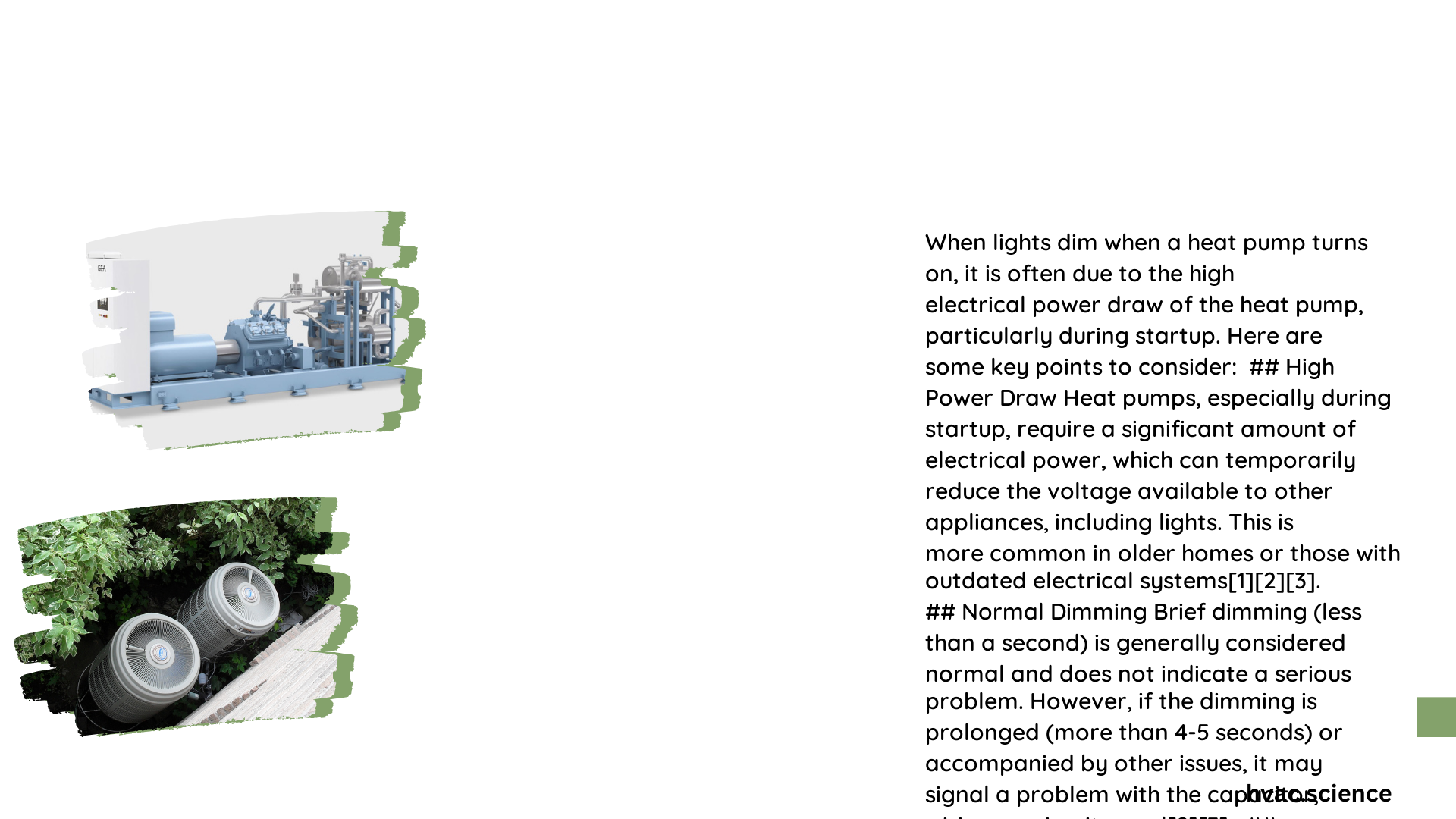When a heat pump turns on, it’s common for homeowners to notice their lights dimming momentarily. This phenomenon is typically caused by the high electrical current draw during the heat pump’s startup phase. The sudden demand for power can lead to a temporary voltage drop in the home’s electrical system, resulting in visible light dimming. Understanding the causes and implementing effective solutions can help mitigate this issue and ensure a more stable electrical environment in your home.
Why Do Lights Dim When Heat Pump Turns On?
The primary reason for lights dimming when a heat pump activates is the substantial electrical current required during startup. Heat pumps, especially their compressors, need a significant amount of power to overcome initial inertia and begin operation. This sudden surge in power demand can cause a momentary voltage drop across the entire electrical system, affecting other devices connected to the same circuit, including lights.
What Is the Typical Electrical Draw of a Heat Pump During Startup?
Heat pumps have two distinct phases of electrical consumption:
- Startup Phase (Inrush Current):
- Also known as Locked Rotor Amperage (LRA)
- Can range from 50 to 120 amps or more
-
Lasts for a fraction of a second
-
Steady-State Operation:
- Much lower, typically around 12-15 amps
- Continues throughout the heat pump’s operation
Here’s a comparison table to illustrate the difference:
| Operation Phase | Current Draw | Duration |
|---|---|---|
| Startup | 50-120+ amps | <1 second |
| Steady-State | 12-15 amps | Continuous |
This stark difference in current draw explains why lights may dim briefly when the heat pump starts but return to normal brightness once it’s running.
How Significant Is the Voltage Drop When a Heat Pump Starts?

The voltage drop when a heat pump starts can be substantial enough to cause noticeable dimming of lights. While the exact drop varies depending on factors such as the heat pump’s size and the home’s electrical system, it’s not uncommon to see a temporary voltage reduction of 5-10% or more.
For example:
– Normal household voltage: 120V
– Potential drop during heat pump startup: 6-12V
– Resulting voltage: 108-114V
This drop, though brief, is often enough to cause visible dimming in incandescent and even some LED lights.
What Are Common Causes of Flickering Lights Besides Heat Pumps?
While heat pumps are a common culprit for dimming lights, other factors can contribute to this issue:
- Loose wiring connections
- Overloaded circuits
- Outdated electrical panels
- Large appliances starting (e.g., refrigerators, air conditioners)
- Utility grid issues
It’s important to identify the specific cause in your home to implement the most effective solution.
How Can I Prevent Lights from Dimming When My Heat Pump Turns On?
Several strategies can help mitigate or eliminate light dimming caused by heat pump startup:
- Install a Soft Start Kit:
- Reduces inrush current by up to 50%
- Cost: $100-$300
-
Effectiveness: High
-
Upgrade Your Electrical Panel:
- Increases overall capacity to handle high current draws
- Cost: $1,000-$4,000
-
Effectiveness: Very High
-
Use a Dedicated Circuit for the Heat Pump:
- Isolates the heat pump’s electrical demand
- Cost: $200-$800
-
Effectiveness: Moderate to High
-
Install a Whole-House Voltage Stabilizer:
- Maintains consistent voltage throughout the home
- Cost: $500-$2,000
-
Effectiveness: High
-
Switch to LED Lights:
- Less sensitive to voltage fluctuations
- Cost: Varies (typically $5-$20 per bulb)
- Effectiveness: Moderate
Are There Any Long-Term Effects of Frequent Light Dimming?
While occasional light dimming due to heat pump operation is generally not harmful, frequent and severe voltage fluctuations can have long-term consequences:
- Reduced lifespan of electronic devices
- Increased wear on the heat pump’s components
- Potential damage to sensitive equipment
It’s advisable to address persistent dimming issues to protect your home’s electrical system and appliances.
When Should I Consult an Electrician About Light Dimming?
Consider contacting a licensed electrician if:
- Dimming is severe or lasts more than a second
- Other electrical issues are present (e.g., flickering, buzzing)
- You’ve noticed an increase in your energy bills
- Your home is more than 20 years old and hasn’t had an electrical inspection
An electrician can perform a thorough assessment of your electrical system and recommend the most appropriate solutions for your specific situation.
By understanding the causes of lights dimming when your heat pump turns on and implementing appropriate solutions, you can ensure a more stable and efficient electrical environment in your home. This not only improves your comfort but also protects your electrical appliances and potentially reduces energy costs in the long run.
References:
1. DIY Solar Forum – Will this addition be adequate to start the heat pump?
2. HVAC-Talk – Heat pump amps
3. Hickory Heating & Cooling – Heat Pump Electrical Requirements: A Guide for Homeowners
